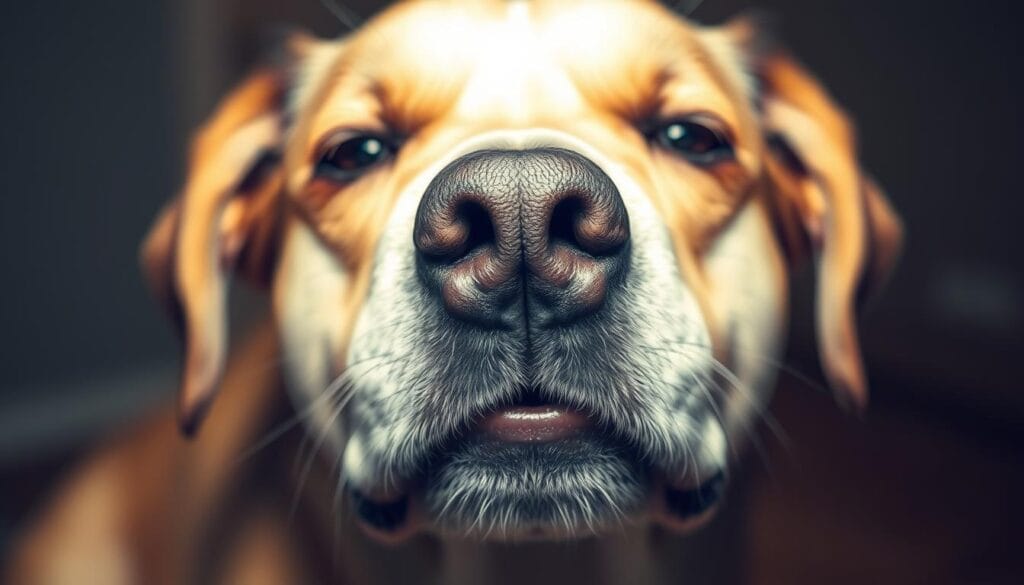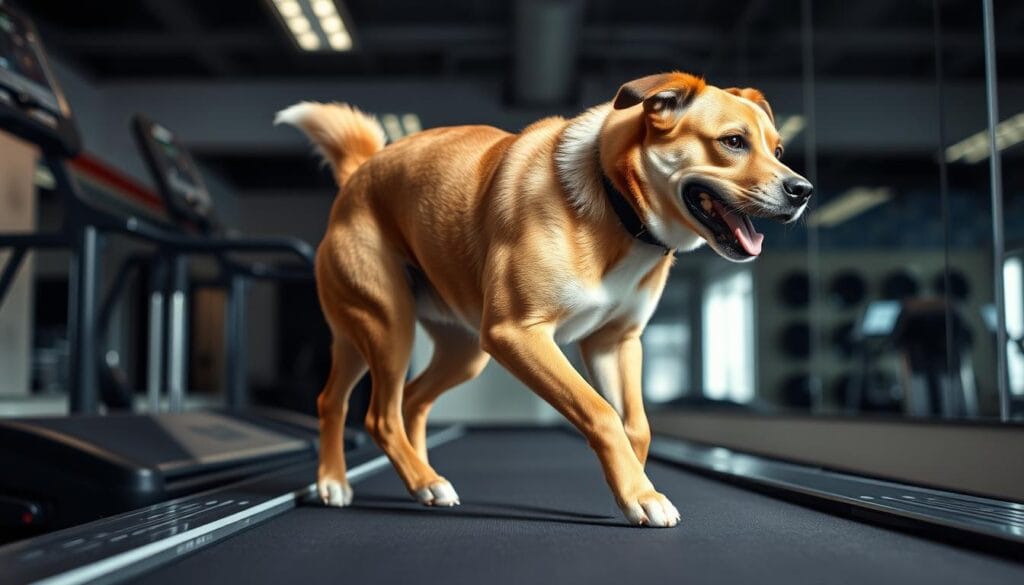Why is My Dog Breathing Fast but Not Panting While Sleeping?

Have you ever watched your furry friend sleeping and noticed something unusual about their breathing? What if your dog is breathing fast but not panting, and you’re unsure whether it’s cause for concern?
Dog breathing fast but not panting while sleeping can be a subtle yet significant signal that something might be happening with your pet’s health. Understanding the nuances of canine respiratory patterns is crucial for responsible pet owners.
Typically, dogs breathe between 15 to 35 breaths per minute while resting. When this rate exceeds 40 breaths per minute during sleep, it becomes an abnormal dog breathing pattern that warrants closer examination.
Dogs communicate through many signals, and their breathing is one of the most important indicators of their overall health and well-being. Rapid breathing during sleep could stem from various factors, ranging from environmental conditions to potential medical issues.
Key Takeaways
- Normal dog respiratory rates range from 15-35 breaths per minute
- Breathing over 40 breaths per minute while sleeping is considered abnormal
- Multiple factors can contribute to fast breathing in dogs
- Monitoring your dog’s breathing patterns is essential for early health detection
- Some breeds are more prone to respiratory variations
- Consult a veterinarian if breathing changes persist
Understanding Normal Dog Breathing Patterns
Dog breathing patterns can vary a lot. Knowing what’s normal helps you keep an eye on your pet’s health. Rapid breathing in dogs during sleep might worry you, but not all unusual patterns mean trouble.
What Defines Normal Breathing in Dogs
A healthy dog usually breathes 15 to 35 times per minute when resting. This number can change for several reasons:
- Age of the dog
- Physical size
- Current activity level
- Environmental temperature
Breathing Differences: Puppies vs. Adult Dogs
Puppies and adult dogs breathe differently. Young dogs breathe faster because of their high metabolism and smaller lungs. Here are some key points:
- Puppies: 15-40 breaths per minute
- Adult dogs: 10-30 breaths per minute
Factors Influencing Breathing Rates
Many things can affect your dog’s breathing rate. Important factors include breed, physical condition, and the environment.
Brachycephalic breeds like Bulldogs and Pugs have unique breathing patterns. Their facial structure affects their breathing. Your dog’s weight, fitness, and health also impact their breathing.
Always watch your dog’s breathing and see a vet if you notice unusual patterns that last.
Exploring Fast Breathing in Dogs
It’s important to know how your dog breathes to spot health issues. The rate of breathing can tell you a lot about your pet’s health.
What is Considered Fast Breathing?
A fast breathing rate in dogs is more than 30 breaths per minute when they’re calm. Normal rates for adult dogs are between 10-30 breaths per minute.
How to Measure Your Dog’s Breathing Rate
Measuring your dog’s breathing is easy to do at home. Here’s how:
- Wait until your dog is calm and resting
- Count the number of chest rises in 60 seconds
- Each chest rise is one breath
- Compare the count to normal rates
Signs of Abnormal Breathing
Spotting breathing problems early can help avoid serious health issues. Look out for these signs:
- Rapid, shallow breathing
- Loud or strained breathing sounds
- Persistent coughing
- Blue or pale gums
- Wheezing or excessive panting
| Dog Type | Normal Breathing Rate | Potential Concern |
|---|---|---|
| Puppies | 15-40 breaths/minute | Above 40 breaths/minute |
| Adult Dogs | 10-30 breaths/minute | Above 30 breaths/minute |
| Senior Dogs | 10-30 breaths/minute | Persistent rapid breathing |
Always consult a veterinarian if you notice persistent or concerning changes in your dog’s breathing pattern.
Reasons for Fast Breathing While Sleeping
Understanding why your dog breathes fast while sleeping is key. It can help spot breathing problems in dogs. These issues can come from natural sleep patterns or health problems.
Dreams and REM Sleep Dynamics
Dogs sleep like humans, with REM sleep included. In this phase, they might breathe faster, twitch, and make soft sounds. These actions are usually normal and show they’re dreaming.
Environmental Factors Impacting Sleep Breathing
Many things can affect how your dog breathes while sleeping:
- Room temperature and humidity levels
- Sleeping surface comfort
- Proximity to heating or cooling sources
- Potential allergens in the sleeping area
Health Conditions to Consider
Some health issues can cause fast breathing in dogs. These include:
- Orthopedic pain causing discomfort
- Respiratory infections
- Heart-related conditions
- Metabolic disorders
If your dog’s breathing seems off, see a vet. They can diagnose and treat the issue.
The Role of Stress and Anxiety
Stress can really affect how your dog breathes, especially when they’re sleeping. Knowing the signs of abnormal breathing linked to anxiety is key. It helps pet owners give their dogs the care and comfort they need.

Identifying Signs of Stress in Dogs
Dogs show stress in many ways. One big sign is rapid breathing without panting. Look out for these stress signals:
- Excessive licking or chewing
- Trembling or shaking
- Decreased appetite
- Tucked tail or lowered body posture
- Avoidance behaviors
How Anxiety Affects Sleep and Breathing
Anxiety can mess with your dog’s breathing while they sleep. Dogs may breathe fast and shallow when stressed. This can happen for several reasons:
| Anxiety Type | Breathing Impact |
|---|---|
| Separation Anxiety | Rapid, shallow breathing during sleep |
| Noise Phobia | Increased respiratory rate |
| Environmental Changes | Irregular breathing patterns |
Tips for Reducing Stress in Your Dog
Helping your dog feel less anxious can improve their breathing and overall health. Try these tips:
- Create a consistent daily routine
- Provide a quiet, comfortable sleeping area
- Use calming pheromone diffusers
- Practice positive reinforcement training
- Consider professional behavioral therapy
Remember, if your dog’s breathing stays off, it could be serious. Always talk to your vet if you see signs of stress or abnormal breathing that last.
Respiratory Issues to Watch For
Dog breathing patterns can tell you a lot about your pet’s health. If your dog breathes fast but doesn’t pant while sleeping, it might mean they have a respiratory problem. These issues need your attention.
Knowing about respiratory problems can help keep your dog safe. Dogs can face breathing challenges that show up as fast breathing while they sleep. This is not normal.
Common Respiratory Problems in Dogs
Many respiratory conditions can affect dogs at any age:
- Chronic bronchitis
- Pneumonia
- Lungworm infections
- Pulmonary hypertension
- Tracheal collapse
Symptoms of Respiratory Distress
Spotting respiratory distress early is key. Look out for these signs:
- Labored breathing
- Pale or blue-tinged gums
- Reluctance to eat or drink
- Open-mouthed breathing while resting
- Excessive coughing
“Early detection of respiratory issues can significantly improve your dog’s prognosis.” – Veterinary Respiratory Specialists
When to See a Veterinarian
Get your dog to the vet right away if they:
- Breathe more than 40 times a minute
- Have abnormal breathing all the time
- Keep coughing or wheezing
- Have trouble breathing
Your dog’s respiratory health needs careful watching and expert advice. Don’t wait to get help if you see unusual breathing.
The Impact of Exercise on Breathing
It’s important to know how exercise affects your dog’s breathing. Dogs breathe differently when they’re active. This can change how they breathe while they’re sleeping.

How Exercise Influences Breathing Patterns
When your dog exercises, their breathing rate goes up a lot. Panting helps them cool down. They do this by letting water and heat evaporate through their mouth and nose.
- Normal resting respiratory rate: 18-34 breaths per minute
- Exercise can temporarily increase breathing to 40-50 breaths per minute
- Brachycephalic breeds require extra monitoring during physical activity
Post-Exercise Recovery in Dogs
After they’ve been active, your dog might still breathe fast for a while. How long it takes to get back to normal depends on their breed, age, and fitness. Puppies and older dogs might need more time.
Balancing Activity and Rest
It’s important to manage your dog’s exercise to avoid breathing problems. Start with gentle activities and make sure they drink enough water. Watch for signs they’re getting too tired. For dogs that have trouble breathing, shorter, easier workouts are best.
Remember: Your dog’s breathing is a critical indicator of their overall health and fitness.
Temperature and Its Effects on Breathing
Dogs have a hard time keeping their body temperature steady. Unlike humans, they can’t sweat well. So, they use breathing to cool down. Knowing how temperature affects their breathing helps keep them healthy in all seasons.
Heat can really affect a dog’s breathing. Owners need to watch for signs of trouble. Dogs cool down mainly by panting, which changes how they breathe.
How Heat Affects Your Dog’s Breathing
When it gets hot, dogs breathe faster to stay cool. Their breathing becomes quicker and shallower. Several things can affect how a dog breathes:
- Ambient temperature
- Humidity levels
- Dog’s breed and coat thickness
- Physical activity level
Keeping Your Dog Cool While Sleeping
To keep dogs cool at night, use smart cooling methods. Here are some tips to keep your dog comfy:
- Use cooling mats or beds
- Provide constant fresh water
- Maintain cool room temperatures
- Avoid heavy blankets
Seasonal Changes and Breathing
Each season brings its own challenges for dogs’ breathing. Watching how your dog breathes can help spot problems early.
| Season | Breathing Challenges | Recommended Actions |
|---|---|---|
| Summer | High heat, increased panting | Limit outdoor activities, provide shade |
| Winter | Cold air, potential respiratory irritation | Limit exposure, use dog sweaters |
| Spring/Fall | Allergen fluctuations | Monitor breathing, keep environment clean |
Always consult your veterinarian if you notice persistent changes in your dog’s breathing patterns across different temperatures and seasons.
Age-Related Changes in Breathing
As your dog gets older, their breathing patterns may change a lot. Senior dogs often face breathing issues that need special care. It’s important to know how aging affects their breathing.
Older dogs might have trouble breathing when they’re resting. This is because their lungs and muscles get weaker with age. This affects how well they breathe.
Understanding Age-Related Respiratory Changes
Senior dogs go through many changes in their breathing:
- Decreased lung capacity
- Reduced oxygen absorption
- Slower respiratory muscle response
- Increased susceptibility to respiratory infections
Monitoring Your Senior Dog’s Breathing
It’s key to check your aging dog’s breathing often. Look out for these signs:
- Unusual breathing sounds
- Persistent coughing
- Rapid breathing during rest
- Visible chest wall movements
Caring for Older Dogs’ Respiratory Health
To help your senior dog’s breathing, try these:
| Care Strategy | Benefit |
|---|---|
| Regular veterinary check-ups | Early detection of respiratory issues |
| Low-impact exercise | Maintains lung function |
| Maintain healthy weight | Reduces breathing strain |
| Humidifier usage | Supports respiratory comfort |
Remember, every dog ages differently. Consult your veterinarian for personalized guidance on managing your senior dog’s respiratory health.
Nutrition’s Impact on Dog Health
Your dog’s diet is key to their health, including breathing. The right food can prevent breathing problems and keep their lungs working well. It’s important to know how what your dog eats affects their breathing.
Some nutrients are good for your dog’s breathing. A diet full of certain nutrients can lower the chance of breathing fast without panting. It also helps keep their lungs strong.
The Connection Between Diet and Breathing
Nutrients that affect breathing include:
- Omega-3 fatty acids for reducing inflammation
- Antioxidants to support lung tissue
- Lean proteins for muscle and respiratory system strength
- Proper hydration to maintain mucus membrane health
Best Foods for Respiratory Health
Eat these foods to help your dog’s breathing:
| Food | Respiratory Benefits |
|---|---|
| Salmon | Rich in omega-3s, reduces inflammation |
| Blueberries | Powerful antioxidants, supports lung health |
| Lean Chicken | High-quality protein, supports muscle function |
| Sweet Potatoes | Vitamin A for mucus membrane health |
Treats and Their Effects
Not all treats are good. Choose treats that support respiratory health and avoid those with too many additives. Some treats can make your dog gain weight, which can make breathing harder.
Tip: Consult with your veterinarian to create a personalized nutrition plan that addresses your dog’s specific respiratory needs.
When to Worry About Fast Breathing
Knowing when your dog’s breathing is a big worry is key for pet owners. Some breathing changes are normal, but others can mean serious health problems that need quick action.
Dogs breathing fast but not panting while sleeping might be a sign of trouble. Vets say to watch for breathing patterns that are different from what’s usual for resting dogs.
Key Indicators Requiring Immediate Attention
Look out for these signs that mean your dog needs to see a vet right away:
- Breathing rate over 40 breaths per minute
- Labored or heavy breathing when resting
- Blue or pale gum color
- Open-mouthed breathing when not active
- Noticeable weakness or extreme tiredness
Differentiating Normal from Urgent Signs
A healthy dog usually breathes 15 to 35 times per minute when resting. If your dog’s breathing is over 35 breaths per minute, it could be a sign of a health problem. Things like breed, age, and recent activity can affect how fast a dog breathes.
First Steps for Pet Owners
If your dog’s breathing seems off, here’s what to do first:
- Count your dog’s breathing for one minute
- Check the color of their gums and how alert they are
- Take away any stress or heat
- Call your vet right away
- Be ready to tell them about your dog’s breathing
Acting fast and getting your dog to a vet can really help their health and recovery.
Seeking Professional Help
If your dog has unusual breathing patterns, it’s important to know when to get vet help. Breathing more than 40 times a minute while resting is a sign of possible health issues. Vets can find out what’s causing the fast breathing and help treat it.
A vet will check many things to understand your dog’s health. They’ll look at breathing rates, listen to heart and lung sounds, and check for physical signs. They might do tests like chest X-rays, blood work, and heart checks to find the cause of fast breathing.
Before you go to the vet, get ready by keeping a record of your dog’s breathing. Note any symptoms you’ve seen and changes in their environment or lifestyle. Dogs with short noses, like Boston terriers and pugs, might need extra checks. Your notes will help the vet figure out what’s wrong and how to fix it.
Getting help early can stop bigger health problems. If your dog breathes more than 35 times a minute while resting, see a vet. Your quick action can really help your dog stay healthy and happy.
